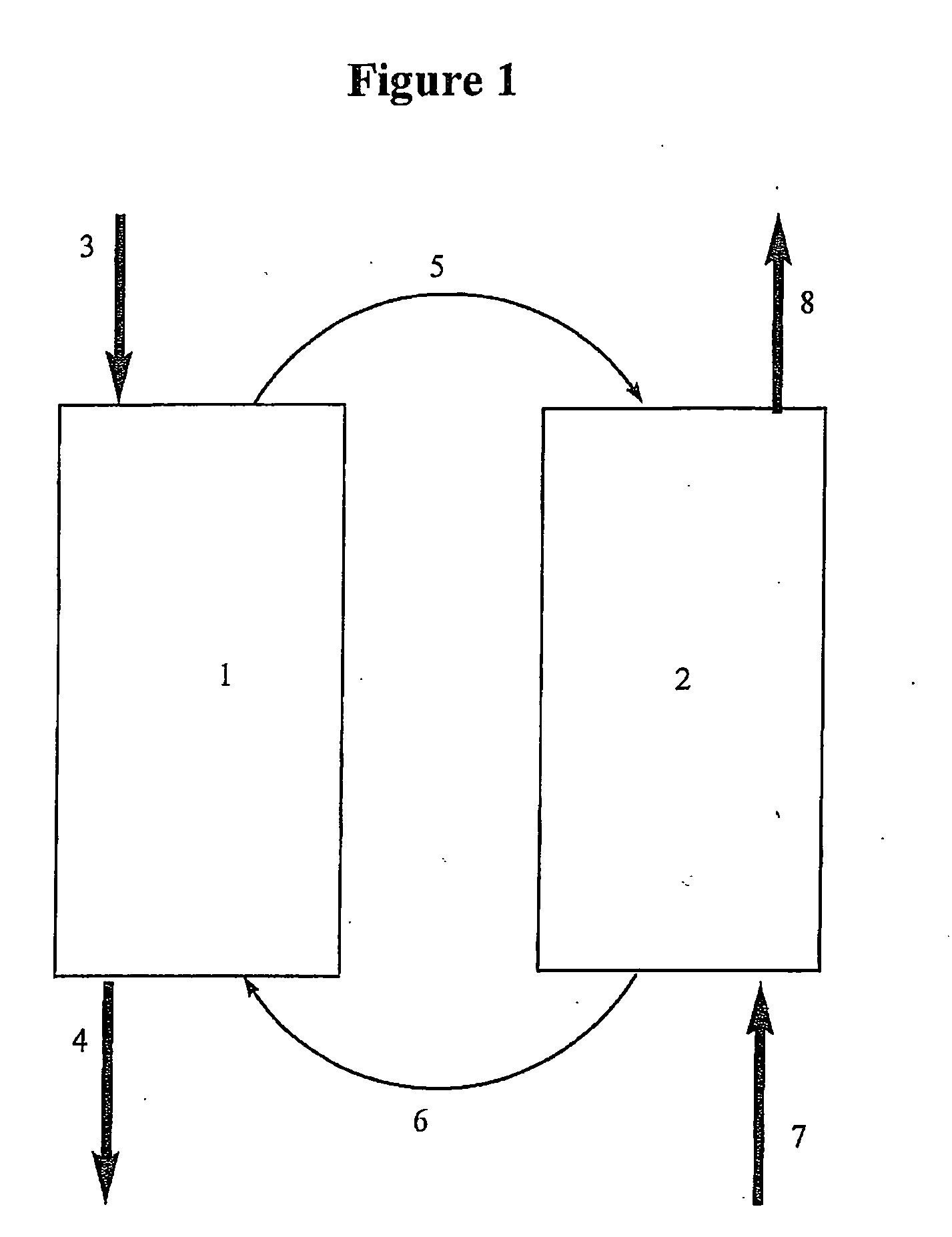Oxydative dehydrogenation of paraffins
- Summary
- Abstract
- Description
- Claims
- Application Information
AI Technical Summary
Benefits of technology
Problems solved by technology
Method used
Image
Examples
example 1
[0054]A selection of metal powders including Fe, Ni and Cr were oxidized by air in a thermal balance. The oxidation started at about 300° C. For iron complete oxidation was reached at 600° C. with Fe2O3 being the end product. However, the weight gains for Ni and Cr suggest incomplete oxidation in the same oxidation period. Further experimental tests were carried out to these oxides and the results show that both Fe2O3 and NiO can be reduced by ethane. However NiO appears to have a more favorable temperature range (400° C. to 600° C.). This example confirms that oxidation of metal (Ni) by air and reduction of the metal oxide (NiO) by ethane can take place in the same or similar temperature range for oxidative dehydrogenation. This confirms the required cycle between metal oxidation and the reduction of the metal oxide.
example 2
[0055]Powders of Ni of a particle size less than 250 mesh mixed with an equal amount of alumina of 140-200 mesh were packed in the reactor of a micro reaction unit (MRU). The reactor bed had a volume of 2 ml. The reactor bed was heated at about 10° C. / min to 600° C. under 50 sccm (standard cubic centimeters) N2 purge. At 600° C. a 25 sccm flow of air was admitted into the packed bed for 150 minutes in order to oxidize the Ni. Then the reactor was cooled in 50 sccm of N2 to 450° C. and held at this temperature for 30 minutes to ensure complete removal of oxygen from the reactor. At the end of the cooling / purging period a stream of ethane was admitted to the reactor at a rate of 50 sccm and the composition in mole % of the reactor effluent was analyzed by a gas chromatograph. Two experiments were carried out under identical conditions and the product compositions are shown in Table 1.
TABLE 1Product Composition in the Absence of Ni / NiOxRun TimeminCH4C2H6C2H4C3H6O2CO253.1693.420.490.001...
example 3
[0057]Example 2 was repeated except that in addition to the Ni alumina powder the reactor contained an oxidative dehydrogenation catalyst (V—Mo—Nb—Te—Ox weight ratios) in a weight ratio of Ni:alumina:oxidative dehydrogenation catalyst of 2:2:1. Two repeat experiments were run using the same conditions as in Example 2. The effluent was analyzed for its composition using a gas chromatograph. The results are shown in Table 2. In Table 2 the amounts of the components are shown in mole %.
TABLE 2Product Composition in the Presence of Ni / NiOxRun TimeMinCH4C2H6C2H4C3H6O2CO250.1196.871.730.000.880.41150.0298.760.940.010.090.16600.0299.110.700.010.060.101201.4897.260.090.000.091.091800.5198.990.080.000.110.312400.2499.310.110.000.110.233000.2399.310.130.000.110.2250.0696.821.920.010.610.57150.0198.721.010.010.040.21600.0399.340.460.000.050.121200.0699.260.380.000.100.211800.1298.890.410.000.120.462400.1598.830.570.010.100.353000.1898.700.720.010.110.28
[0058]These results show an enhancement o...
PUM
| Property | Measurement | Unit |
|---|---|---|
| Temperature | aaaaa | aaaaa |
| Temperature | aaaaa | aaaaa |
| Temperature | aaaaa | aaaaa |
Abstract
Description
Claims
Application Information
 Login to view more
Login to view more - R&D Engineer
- R&D Manager
- IP Professional
- Industry Leading Data Capabilities
- Powerful AI technology
- Patent DNA Extraction
Browse by: Latest US Patents, China's latest patents, Technical Efficacy Thesaurus, Application Domain, Technology Topic.
© 2024 PatSnap. All rights reserved.Legal|Privacy policy|Modern Slavery Act Transparency Statement|Sitemap

